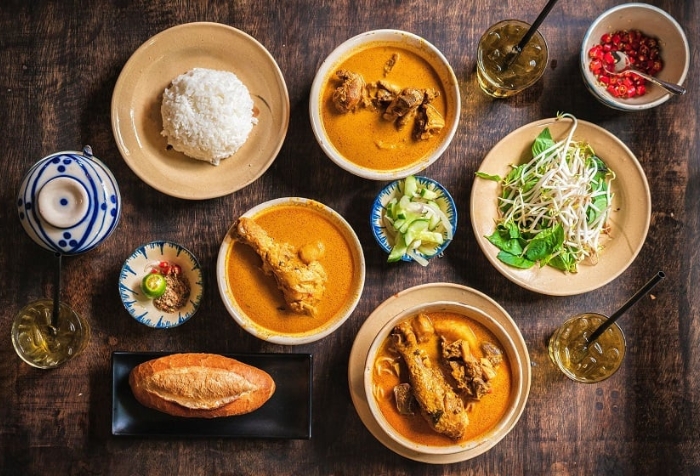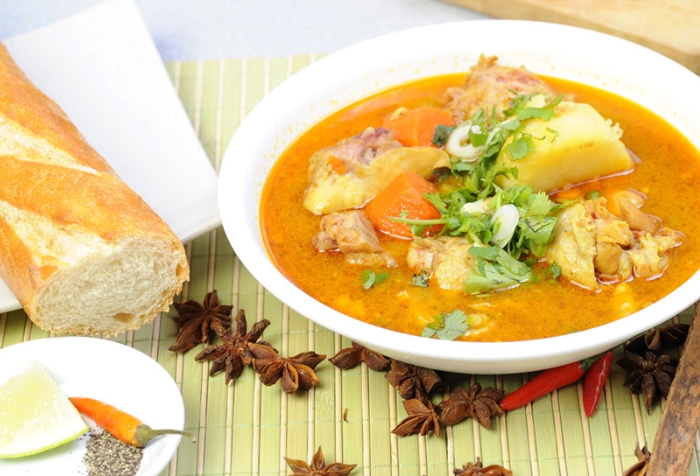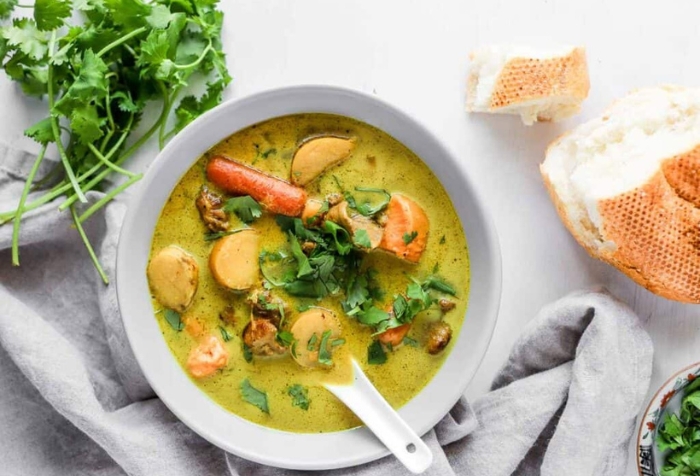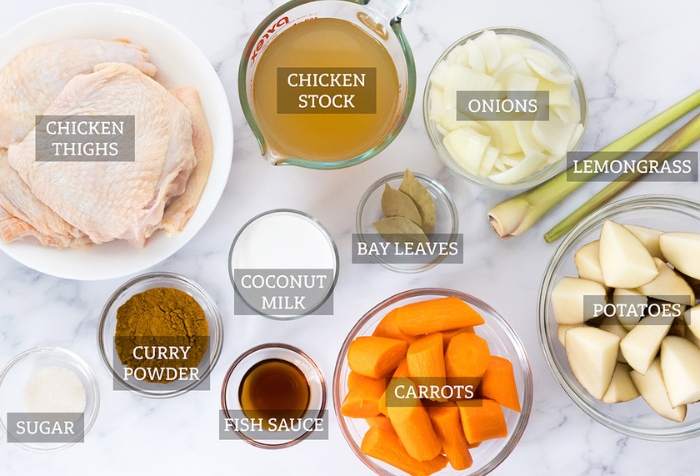If you're planning a trip to Vietnam, you'll have the chance to explore a country renowned for its mouthwatering cuisine. Among the many fascinating dishes, Vietnamese chicken curry, also known as "cà ri gà," stands out and captivates the interest of tourists. This dish blends aromatic spices with a creamy texture, creating a hearty and satisfying meal that truly embodies the rich flavors of Vietnamese cuisine. Join Autour Asia as we delve into the special qualities of Vietnamese curry.
I. Overview about Vietnamese curry
1. What is Vietnamese curry?
Vietnamese curry is a delicious dish originating from India, taken from the word "kari" in Indian Tamil, meaning "sauce" that are characterised by their use of complex combinations of spices or herbs, typically including ground turmeric, cumin, coriander, ginger, and fresh or dried chilies. This dish is so famous all over the word that many countries have brought curry recipes back, adding some ethnic and soil elements, making the versions become culinary characteristics of that country, and that includes Vietnam. When creating a curry dish, one can choose from a spectrum of options, including non-spicy to fiery-hot, based on their desired level of spiciness.
2. Vietnamese curry’s history in brief
Vietnamese curry has a multifaceted history, drawing influences from both Indian and French cuisines. It is believed that Indian traders introduced curry to Vietnam, which was later adapted and modified by the local palate. French colonial influence also played a role in shaping the dish, particularly in the use of certain cooking techniques and ingredients like potatoes and carrots. According to many documents, the Indian community came to Saigon in the early 1870s until the early 20th century. They often did business in the areas around Cho Lon, Ben Thanh Market, ... and spread to many localities in Mekong Delta, causing Vietnamese cuisine to have more or less interference.
Vietnam's soil is favoured for the development of natural herbal spices such as: Cinnamon, star anise, turmeric, lemongrass, etc. After a period of travelling to Vietnam, the curry flavour has been mixed by the Vietnamese, adding ingredients to create a curry flavour suitable for Vietnamese people.
3. What is the specialty of Vietnamese chicken curry?
Vietnamese chicken curry is somewhat different from India. Ca ri ga in Vietnam rarely has a spicy taste - a taste that is considered a characteristic of curries in general. Instead, this Vietnamese dish has a sweet, fatty taste because it is cooked from coconut milk. And most curries in Vietnam have chicken and potatoes as the main ingredients.
Ca ri vietnamese curry broth has a slightly thick texture due to the powder dissolved from the potatoes. And today, Vietnamese curry is also varied in dishes such as: shrimp in curry sauce, curry rice, frog curry, fish curry, etc... to suit Vietnamese people's tastes and love of curry flavour.
Ca ri ga is a familiar dish on the Vietnamese menu. The fatty flavour of coconut milk, mixed with a bit of the characteristic aroma from curry powder, creates a bold Vietnamese dish that many people love. And curry has become popular from popular shops to restaurants, to almost every family.
II. Vietnamese chicken curry recipe in general
1. Ingredients
If you want to make a delicious
Vietnamese chicken curry at home, you'll need key ingredients like bone-in chicken pieces (drumsticks and thighs) for tenderness, Vietnamese curry powder for its aromatic blend, and vegetables like potatoes and carrots for texture. Coconut milk forms the creamy base, while lemongrass, shallots, and garlic enhance the fragrance. Fish sauce, especially
Phu Quoc fish sauce, adds a distinctive umami flavor. Saute everything in vegetable oil and adjust the taste with salt, sugar, and chili peppers.These ingredients come together to create a flavorful and aromatic
Vietnamese curry that is both hearty and satisfying.
2. How to make Vietnamese chicken curry?
With the ingredients ready, you can follow our guide on how to prepare Vietnamese chicken curry:
Step 1: Marinate the Chicken: In a large bowl, mix the chicken pieces with 1 tablespoon of curry powder, a pinch of salt, and 1 teaspoon of sugar. Let it marinate for at least 30 minutes.
Step 2: Prepare the Vegetables: Peel and cut the potatoes and carrots into chunks. Cut the onion into wedges.
Step 3: Cook the Aromatics: In a large pot, heat the cooking oil over medium heat. Add the minced garlic, ginger, and shallots, and sauté until fragrant. Add the bruised lemongrass stalks and continue to sauté for another minute.
Step 4: Brown the Chicken: Add the marinated chicken pieces to the pot and cook until they are browned on all sides. Add spices and liquids: stir in the remaining Vietnamese curry powder and turmeric powder. Add the coconut milk, water or chicken broth, and fish sauce. Bring the mixture to a boil, then reduce the heat to a simmer.
Step 5: Cook the Vegetables: Add the potatoes and carrots to the pot. Cover and simmer for about 20-30 minutes, or until the chicken and vegetables are tender. Taste the curry and adjust the seasoning with more salt, sugar, or fish sauce if needed. If you prefer a thicker curry, you can continue to simmer it uncovered until it reaches your desired consistency.

The steaming and fragrant this dish can be savoured in various ways. It pairs excellently with Vietnamese baguette, rice noodles, or steamed jasmine rice, each complementing its rich flavours. For an enhanced culinary experience, consider adding a side of chilli salt with lime and a medley of fresh herbs such as coriander and mint. Ca ri ga stands out as a wholesome meal among the many Vietnamese options.
III. Where to enjoy Vietnamese curry?
Vietnamese curry, known for its rich and aromatic flavours, can be enjoyed in a variety of settings throughout Vietnam. Here are some places where you can savour this delightful dish:
1. Curry House Maiya Restaurant
Located in the bustling Old Quarter of Hanoi, Curry House Maiya is renowned for its exceptional Vietnamese chicken curry. The restaurant offers a cosy and inviting atmosphere, blending modern and traditional Vietnamese decor. Known for its richly spiced and flavorful dishes, Curry House Maiya provides a diverse menu that caters to various tastes. With its commitment to quality and outstanding service, it has become a favourite among both locals and tourists. A visit to Curry House Maiya ensures a delightful and memorable dining experience in the heart of Hanoi.
2. Namaste Hanoi Restaurant
After an exhilarating day of exploration, take a moment to unwind at Namaste Hanoi, where you can savour the finest Indian and Asian dishes, including the best ca ri vietnamese curry. This renowned restaurant offers a diverse menu featuring an array of intriguing curries, each prepared with premium ingredients and a masterful blend of spices. The ambiance at Namaste Hanoi is both inviting and elegant, providing the perfect setting for a relaxing meal. Experience the pinnacle of Vietnamese culinary delight at Namaste Hanoi, where every dish promises a taste of heaven and a memorable dining experience.
3. MAAZI Old Quarter Restaurant
MAAZI Old Quarter is renowned as one of Hanoi's premier spots for Vietnamese curry. The restaurant offers a menu brimming with richly spiced and flavorful curry dishes, crafted with the finest ingredients. From classic chicken and potato curry to innovative seafood and vegetable options, each dish provides an authentic taste of Vietnamese cuisine. Whether you're a local or a tourist, MAAZI Old Quarter is a must-visit for an unforgettable Vietnamese chicken curry experience. Enjoy a memorable meal at MAAZI, where every dish is a feast for the senses.
Vietnamese curry is a delightful fusion of flavours that embodies the rich culinary heritage of the country. Its unique blend of spices, fresh ingredients, and aromatic herbs creates a dish that is both comforting and exciting. For tourists exploring Vietnam, indulging in a bowl of Vietnamese chicken curry is an essential experience that offers a taste of the country's diverse and vibrant food culture. Don't miss out on this must-try delicacy that perfectly captures the essence of Vietnamese cuisine.
What is Vietnamese curry powder made of?
It forms the foundation of the powder, imparting a vibrant yellow hue and a piquant, fragrant taste. Annatto – Ground annatto powder lends curries a richer orange tint. It doesn't contribute significant taste as its primary purpose here is for coloring. Five-spice – Five-spice is a spice mixture originating from China
What is Vietnamese curry similar to?
Vietnamese Chicken Curry (Cà Ri Gà) – Bun Bo Bae Vietnamese chicken curry has a thinner consistency compared to Japanese or Thai curry. Its flavor is more akin to Japanese curry but incorporates a gentle sweetness from coconut milk similar to Thai curry. There's truly nothing more delightful than dipping a warm piece of bread into the flavorful broth!
Vietnamese chicken curry is quite different from Thai or Indian curry
I can confirm that Vietnamese curry is quite different from Thai or Indian curry. It's not unusual for it to be made with neck or other less common parts of the chicken.Vietnamese Ca Ri Ga is typically prepared with bone-in chicken and is usually a mildly spiced yellow curry. It is not overly spicy, so it doesn't require a lot of coconut milk, yogurt, or cream to balance the heat, making it less rich.In terms of meat quantity and quality, what you described would be quite typical in Vietnam. However, expectations in the US are different. If the dish was very inexpensive, it might not be reasonable to complain, but if it was costly, then your dissatisfaction is understandable.Personally, I have a fondness for this curry, though I see it more as a 'hearty meal' than 'gourmet cuisine'.





























